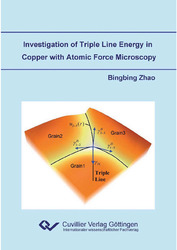| Departments | |
|---|---|
| Book Series (96) |
1378
|
| Nachhaltigkeit |
3
|
| Gesundheitswesen |
1
|
| Humanities |
2365
|
| Natural Sciences |
5406
|
| Engineering |
1793
|
| Engineering | 292 |
| Mechanical and process engineering | 862 |
| Electrical engineering | 686 |
| Mining and metallurgy | 30 |
| Architecture and civil engineering | 75 |
| Common |
98
|
|
Leitlinien Unfallchirurgie
5. Auflage bestellen |
|
Advanced Search
Investigation of Triple Line Energy in Copper with Atomic Force Microscopy (English shop)
Bingbing Zhao (Author)Preview
Table of Contents, Datei (34 KB)
Extract, Datei (230 KB)
In this study, the grain boundary-free surface line tension and grain boundary triple line tension were investigated on copper polycrystals, nanowires, and tricrystals through a thermodynamically correct approach which allows a direct and precise measurement of the line tension. The grain boundary-free surface line tension was determined by comparing the dihedral angle at the root of a flat and a curved grain boundary groove. A measurement of grain boundary triple line tension was achieved by the investigation of the force equilibrium at a triple junction as established by the inclination of the adjourning grain boundary grooves at the root of the triple junction. The experimental technique utilized atomic force microscopy (AFM) to scan the surface topography of grain boundary thermal grooves and triple junctions.
The mean value of the dihedral angle on a flat grain boundary groove in copper polycrystals was 161.8°, with a scatter of 2.3°. Assuming a surface energy of 1.75J/m2, the corresponding grain boundary energy was about 0.6J/m2. The grain boundary energies of a low angle grain boundary (9.4°<100>) and a special grain boundary (near Σ=17) were only 0.4J/m2. By comparing the dihedral angles at the root of a grain boundary groove on random grain boundaries and nanowires, the grain boundary-free surface line tension was derived to be (2.1±0.9)×10-8J/m on average. It was demonstrated that the normal shape of a thermal groove and a negative value of the grain boundary-free surface line tension can not be in equilibrium.
Copper tricrystals with specific orientations were fabricated by the vertical Bridgman technique. The triple line in a <111> tricrystal consisted of three high angle tilt grain boundaries. In a <100> tricrystal; there was a low angle tilt grain boundary, whereas a <110> tricrystal contained a low-Σ grain boundary. The grain boundary triple line energy in the <100>, <110>, <111> tricrystals was (5.3±1.9)×10-9J/m, (6.3±2.3)×10-9 J/m, (9.2±2.7)×10-9J/m, respectively. The magnitude is in agreement with the investigations of the contact triple line of liquid phases. It was found that, the grain boundary triple line energy will be reduced when there is a low energy boundary among the intersecting boundaries.
When the grain boundary-free surface line tension is taken into account for the Gibbs-Thompson relation, the equilibrium concentration of vacancies in the vicinity of a void at the grain boundary is strongly affected by the grain boundary-free surface line tension if the radius of the void approaches the order of ten nanometers.
It was shown that for grain growth in nanocrystalline materials, the triple line energy has to be taken into account for the driving force. defines the grain size for which the grain boundary and triple junction contribution to the driving force are equal, in copper .
Based on the conditions of thermodynamic equilibrium, the classical form of the Zener-force was revisited and modified. To account for the impact of junctions that are formed at the intersection of a particle with a grain boundary it is demonstrated that a particle can not intersect a grain boundary spontaneously, but a certain driving force needs to be applied to the grain boundary to overcome the energy barrier caused by the particle-grain boundary triple line energy. In the course of the interaction process the grain boundary first gets curved by the particle and eventually will intersect the particle. So, the effect of triple line energy prevents a grain boundary to wet particles if they are smaller than 10-40nm (in copper)
From the observations and their physical consequences presented in this study, it is concluded that the energy of a triple line requires a reconsideration of classical effects which impact recrystallization, grain growth and microstructure evolution in fine grained and nanocrystalline systems.
| ISBN-13 (Printausgabe) | 3869559462 |
| ISBN-13 (Hard Copy) | 9783869559469 |
| ISBN-13 (eBook) | 9783736939462 |
| Language | English |
| Page Number | 118 |
| Edition | 1 Aufl. |
| Volume | 0 |
| Publication Place | Göttingen |
| Place of Dissertation | Aachen |
| Publication Date | 2011-11-25 |
| General Categorization | Dissertation |
| Departments |
Engineering
|
| Keywords | junction; Grain boundary triple line energy; Grain boundary free surface energy; Tricrystal, AFM |








